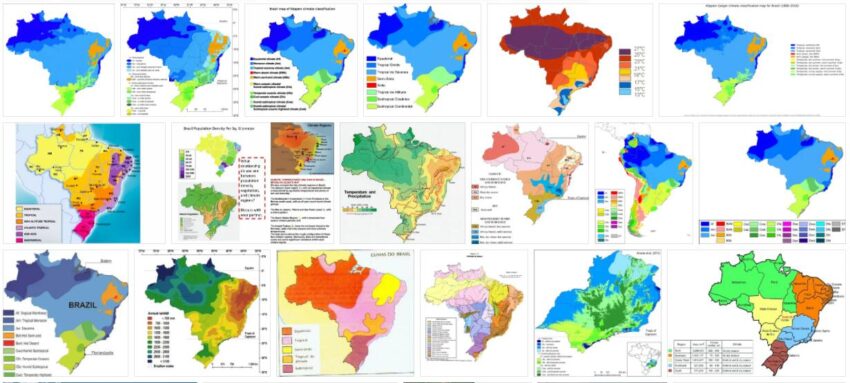There are several climatic classifications based on the study of the dynamics of the air masses, of the elements and of the factors of the climate of Brazil.
Wilhelm Köppen’s classification, the most accepted, studies the elements of the climate separately . It is based, predominantly, on temperature, rainfall and the distribution of the values of these two elements of the climate during the seasons.
The Köppen classification, adapted to Brazil by geographer Lísia Maria Cavalcanti Bernardes, you can see on the map below.
The location of most of Brazil in the intertropical zone and the predominance of low altitudes are responsible for the hot climatic varieties (averages above 20º C), controlled by some air masses and fronts in the country.
EQUATORIAL CLIMATE
It dominates the approximately 5 million km² of the Legal Amazon. Which corresponds to the Amazon : Acre, Amazonas, Amapá, Rondônia, almost the entire state of Pará (except the southeast portion), the northwest of Maranhão and Mato Grosso and part of Roraima.
It is characterized by average temperatures between 24º C and 26º C and in the coldest month is over 18º C, with an annual thermal amplitude of up to 3 degrees, abundant rainfall (more than 2,500 mm / year) and well distributed.
The action of the continental equatorial mass (mEc) produces local (or convention) rainfall through evapotranspiration. In winter, occasionally, the region receives cold fronts originating from the Atlantic polar mass (mPa), causing coldness. Atmospheric humidity is high, usually over 80%.
TROPICAL WEATHER
The tropical climate covers almost the entire area corresponding to the Brazilian plateau, dominates extensive areas of the Central plateau and the Northeast and Southeast regions. Its temperatures are also high, but this type of climate differs from the equatorial one in that it has two seasons well delimited by the rains: It presents a hot and dry winter and a hot and rainy summer.
The average temperatures are above 20º C, with an annual thermal amplitude of up to 7 degrees and rainfall from 1,000 to 1,500 mm / year.
But for the Northeast, the dry season is becoming longer, making the transition to the semi-arid climate.
On the eastern coast of the Northeast (from Rio Grande do Norte to the coast of Bahia), rains again become abundant, falling predominantly in autumn and winter.
Due to the influence of (higher) latitude and relief, in the Southeast these characteristics undergo some modifications, which give rise to the tropical climate of altitude.
ALTITUDE TROPICAL CLIMATE
It corresponds to the highest areas of the Brazilian relief, represented by elevations of the mountains of Mar and Mantiqueira, as well as by the plateau that extends to the north of São Paulo, south of Minas Gerais and Mato Grosso do Sul.
The monthly temperature averages that characterize this climate are between 18º and 22º C, with annual thermal amplitudes of 7 to 9 degrees and precipitation between 1,000 and 1,500 mm / year, with no major differences between the tropical altitude and the tropical climate, since the wettest months, in the areas where this type of climate occurs, coincide with spring and summer (September to March) and the drought, with autumn and winter (April to September).
The summer has more intense rains, due to the humid action of the Atlantic tropical mass (mTa). In winter, cold masses originating from the Atlantic polar mass (mPa) can cause frosts with temperatures below 0ºC.
ATLANTIC OR COASTAL TROPICAL CLIMATE
It operates on the Atlantic façade from the south of Rio Grande do Norte to the south of Rio Grande do Sul. Average temperatures between 18º and 26º C, with increasing thermal amplitudes as latitude increases.
The abundant rainfall exceeds 1,200 mm / year, but has an uneven distribution. On the northeastern coast, they are concentrated in autumn and winter and further south in summer.
SEMI-ARID CLIMATE
The semi-arid climate is characterized, predominantly, by the scarcity of rain. This type of climate dominates the northeastern hinterland .
When normal years occur, the rains that fall in the proper period meet the needs of the inhabitants. The situation becomes dire only when they stop falling in due season, thus prolonging the dry season.
In fact, abnormal droughts do not only occur in the area comprised by the northeastern hinterland, but also include areas that are more distant from the influences of the semi-arid climate. It is characterized by high thermal averages, around 27º C, with extremes, such as Sobral, in Ceará, with a monthly average of 28.9ºC (in December). Annual thermal amplitude around 5 degrees. Few and irregular rains (less than 800 mm / year).
SUBTROPICAL CLIMATE
It occurs in most of the southern plateau. It predominates in the temperate zone south of the Tropic of Capricorn, except in the north of Paraná. It is characterized by average temperatures below 18º C, with an annual thermal amplitude between 9 and 13 degrees.
In the higher areas, the summer is mild and the winter is harsh, with constant frosts and occasional snowfalls. Many rains (between 1,500 and 2,000 mm / year), and well distributed.

